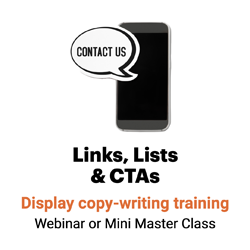They read 3.5% of the words on the page
Consider the numbers:

- 43% of people skim blog posts instead of reading them, according to Hubspot.
- 55% of people spent fewer than 15 seconds on an article, according to ChartBeat.
- That means people read about 50 words, on average, of a post, using an average reading rate of 200 words per minute.
- The average blog post is 1,416 words long, according to OrbitMedia.
Which means that audience members read, on average, 3.5% of the words on a post.
They don’t read the text. Instead, their “reading strategy” is to skim.
Beyond blog posts
It’s not just blog posts. People skim and scan text in other online channels and devices, as well:
- How people read on the web: They don’t; so make webpages scannable
- Do people skim, scan, read emails? Just 19% of email newsletters get read thoroughly
- People skim and scan text in online news: Only 25% read word by word
- Eye tracking online shows where people look: Change how people see your page with 6 eye gaze patterns
- People are skimming text on tablets: Insights from Poynter’s EyeTrack study
Which words do they read?
So how do you reach nonreaders with words? Put your message where their eyes are — in the microcontent and display copy.
So which words do they read? Your audience members look at magnetic elements, including:
So put your message where their eyes are — in the display copy.
Pass The Palm Test.
So break up walls of words to make messages look easier to read.
In one study, Jakob Nielsen and Kara Pernice Coyne rewrote a New York Magazine post about New York City restaurants. They added more bullets, bold-faced text, highlighted key words and white space to break up walls of words and make the message look easier to read.
Audience members spent about twice as much time with the original page. But they remembered 34% more of the content on the revised page. But they:
- Understood 12% better
- Remembered 34% more of the piece
- Enjoyed the experience significantly better
Pass The Skim Test.
In another study, Nielsen Norman Group researchers rewrote a New York Times article about Nobel Prize winners. They made the piece significantly more scannable with:
- Subheads
- Bulleted lists
- Highlighted key words
As a result, audience members:
- Spent 3% more time reading the article.
- Understood it 12% better.
- Enjoyed it 7% more.
Not a bad return on a few bullets and bold-faced words!
How can you reach people who skim through your text?

Leave a Reply